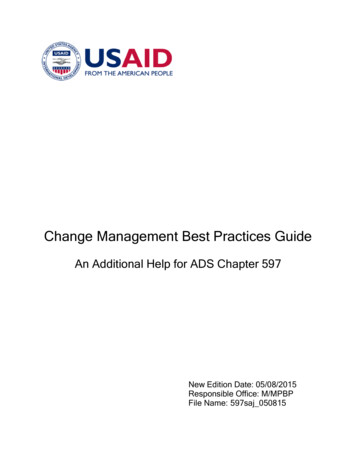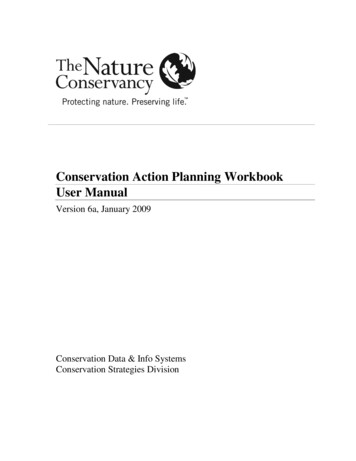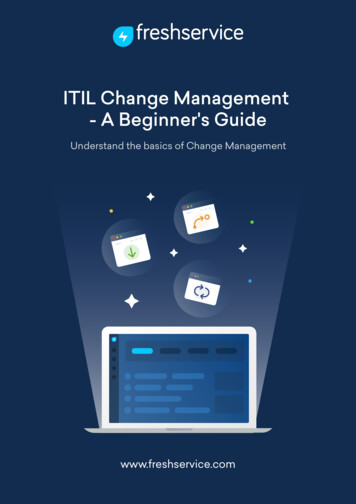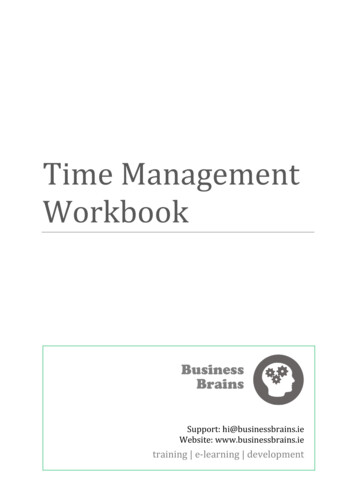
Transcription
Change Management PlanWorkbook and Template)
Change Implementation PlanTABLE OF CONTENTSStep 1 Identify the change.change. 11.1.1.2.1.3.1.4.1.5.1.6.1.7.Type of change . 1Reason for the change . 1Scope the change . 1Where are you now? . 1Where do you want to be? . 3What are the five (5) concept shifts required for this change to occur? . 3Check organisation change readiness . 3Step 2 Particulars of the change.change. 32.1.2.2.2.3.2.4.2.5.2.6.How will you get there? . 3Process Change . 4People Change . 4Information sharing . 4Cost of change . 4Risk Assessment . 4Step 3 Change Approach . 53.1.3.2.3.3.Stakeholder Analysis.Analysis. 5Resistance to change . 6Role of Change Management Team . 6Step 4 Implementation strategies . 74.1.4.2.4.3.4.4.4.5.Action Plan . 7Communication Plan . 7Training Plan.Plan. 8Business Systems Plan . 8Resistance Plan . 8Step 5 Develop implementation package. 9Step 6 Review change strategy . 96.1. Ongoing Monitor and Review . 9Appendix A . 10Appendix B . 11Appendix C . 12Appendix D . 13Appendix E . 14AttachmentAttachment 1. 16Organisational Change Readiness Checklist. 15Attachment 2. 17Risk Assessment Matrix. 17Risk Assessment Table . 18Attachment 3. 20Resistance Assessment Survey . 19CHANGE MANGEMENT PLAN TEMPLATE . 20
Change Implementation PlanPurpose of this documentThe Change Management Plan has been developed to assist the Business Process Owner. It is useful when achange is made to a process or system to ensure that it is implemented effectively into the business. It assistsin designing and estimating the scale of the change effort, mobilising the will to change and gaining the buybuy-in.This document is designed to be used alongside or can be incorporated into the proper project plan.The Change Management ProcessChange management is a process that should be included in the planning and delivery of a project from thevery beginning. Often times change is not taken into consideration in the development of project plans. It is forthis reason that change management has been addressed as separate component to the usual projectmethodology that you maybe currently using. Once the change management plan has been developed it shouldbe integrated with the project plan and can be included at any point after start up.This change management plan template provides the necessary flexibility required and is designed to meet theneeds of the project irrelevant to the phase of the project.The change management process has three stages, and should be considered alongside the nature andmagnitude of the change.Implementation of ChangeDetails of Change Identify the change Particulars of the change Change approach Implementation strategies Release StrategyOUTPUT Schedule of ActivitiesAction PlanCommunication PlanTraining PlanResistance to Change PlanEmployee Change Readiness PlanPlanRelease PlanReview StrategyOUTPUTCHANGE MANAGEMENTPLANReview of ChangeAppraisal of changestrategy
Change Implementation PlanCHANGE MANAGEMENT PLAN WORKBOOKHow to use this ToolkitThe following toolkit takes you through a series of steps that help to identify each of the keycomponents of the change management process. This tool will help build a roadmap to effectivelydesign, plan, lead and monitor the change.The format of the toolkit consists of two sections:Section One is the Change Management Plan Workbook which is broken down into the threestages of change and provides guidelines, processes and checklists to help you analyse thechange for successful implementation of your project.Section Two is a template that can be completed whilst working through the workbookactivities. This information will provide the basis for the development of a successful changemanagement plan.STAGE A: DETAILS OF THE CHANGEIDENTIFY THE CHANGESTEP 1At the end of this step you will have:have:Identified the situation that has brought about the changeIdentified the size and the characteristics of the changeDefined the current stateDefined what the future will look likeIdentified the concept shiftsIdentified the organisational readiness to change1 .1 .Type of changeDescribe the type of change.Which of the following does it look like?Policy changeScale of the change - large or smallProcess changeSpeed of change - fast or slowSystem changeOtherChanged job roles1 .2 .Reason for the changeDescribe the reason for the change – example: Business benefit
Change Implementation Plan1 .3 .Scope the changeDescribe who in the business it includes?How far reaching in the organisation is the change?DepartmentPeopleWork GroupsSystemsBusiness UnitOtherDivisionIs it the same for each of the business units?1 .4 .Where are you now?Describe the situation in the organisation currently.Describe the problem.What is the cause?Define the context and challenges surrounding your initiative.1 .5 .Where do you want to be?Describe what the future state will bring.Describe what it will feel like.Describe what it will look like.Describe what you will see people doing / saying.Describe what will be done differently.Describe what roles will be affected in the organisation and how.Describe what will improve.The SLM Maturity Framework could be used as a benchmarking tool here to articulate thekey areas of improvement from the current state to future state. It can be found in the SLMImplementation Toolbox on the QGCIO sitesite SLM Implementation Toolbox.Toolbox1 .6 .What are the five (5) concept shifts required for this change to occur?In order to bring about this future state it will require new ways of thinking. This is usuallybrought about by a paradigm or mind shift.Describe what will be the gap.Describe how people will need to think differently about this change.1 .7 .Check organisational change readinessA detailed readiness checklist must be completed to ensure all elements of the changehave been addressed.Identify preliminary work to be assessed prior to implementation.Training needs analysis.Workforce capacity.See Attachment 1 – Organisational change readiness checklist
Change Implementation PlanPARTICULARS OF THE CHANGESTEP 2At thethe end of this step you will be able to:to:Consider a range of options, solutions and actions to implement the changeEstimate the cost of changeAssess the risks involved in implementation of the change.2 .1 .How will you get there?There will be a number of areas in the organisation that will be impacted on as a result of thischange and each area needs to be given consideration.RationalDo you need a new organisation structure?Do you need new systems?Will you need new processes?Non-rationalWhat relationships will change?Will the culture embrace or reject this change?How will the stakeholders share information and transfer knowledge?2 .2 .Process ChangeProcess changes tend to be more complex so you may want to consider the followingquestions to add more clarity.Does this change represent a completely new process for the organisation, or adifferent application of an existing process?What are the major changes to processes?(You may need to ‘break this down’ into discrete components to allow tangible descriptions.)What is going to be done differently?(You may need to ‘break this down’ into discrete components to allow tangible descriptions.)2 .3 .People ChangeIn the process of making this change there may be an affect on people’s job roles andresponsibilities. Change will invariably confront many relationships especially those thatrequire a set of new behaviours.What roles within the organisation are affected, and how?What pre-requisite knowledge or training is required?What work practices will be affected?Is there a need for new relationships to be built? (third party)What new behaviours are required?The Roles and Responsibility Guide from the QGCIO site SLM Implementation Toolboxcould be used as a guide for new role descriptions.descriptions.
Change Implementation Plan2 .4 .Information SharingThroughout the process of change information will be distributed and interpreted by staff inmany different ways. It is this process that will be important in managing expectations anddealing with the rumour mill.What policies and procedures need to be changed?What methods are used for sharing current and updated information and does thereneed to be new channels developed? (Intranet, daily messages etc.)What processes are in place to manage the knowledge about the project?2 .5 .Cost of changeUnderstanding the real cost to the organisation in implementing a change initiative is oneway of overcoming key barriers to successful change. Gaining the right level of resourcing isimportant and should be considered upfront.What would be an estimate of the total cost for the activities required to carry out thechange initiative?Where will the funds come from?Has this been negotiated with the customer and sponsor?2 .6 .Risk AssessmentIn the process of considering the different aspects of the change we need to consider whatmight happen leading up to and implementing the change as well as what may be theunintended consequences of the change. Keep in mind that the larger and more disruptivethe change the greater the risk whereby small and incremental change will have less risk.The Risk Matrix will allow you to assess the likelihood and consequences of the change toindicate whether the activity is a low, medium or high risk to the project.What risks may occur upfront, during implementation and after implementation?What tactics will you put in place to minimise these risks?The The Risk Assessment Template (GEA) could be use. It can be found in the SLMImplementation Tool box on the QGCIO site SLM Implementation Toolbox.See Attachment 2 – Risk Assessment Matrix and Table
Change Implementation PlanCHANGE APPROACHSTEP 3In designingdesigning your approach to the change you will be able to:Identify the stakeholders and their rolesIdentify barriers of resistanceIdentify a change management team with their roles and responsibilities3 .1Stakeholder Analysis PyramidIdentifying the levels of participation of stakeholders in the change process allows you tomake sure that a wide variety of interests are taken into account. The impact assessment ofthe change at each of the participation levels will provide you with valuable information as tohow stakeholders may react to the change. This information will also identify at what levelstakeholders need to be engaged at i.e. advocates, drivers, or participators etc.What are the specific target groups/audiences that will be impacted by this change?Who might be able to help you the most? (advocates, early adpoters)Who might present the most resistance?Who will be the change levers? (drivers)List the roles in the following diagram or use the table to identify who or what groups ofpeople will participate at each of the various levels.In the case of the sponsors role in driving the change you may want to consider the skillslevel they may have in change management. If this is limited then a coaching plan should beconsidered.[List Role]Driving[List Role]Advocacy[List Role]Active Participation[List Role]Willingness[List Role]UnderstandingDiagram 1: Levels of Participation
Change Implementation PlanLevel ofParticipationWhoDescription of StakeholderDrivingList the name ofthe generic roleof Individuals orGroupsStakeholders at this level are directly impacted by the change andhave some responsibility for the change process. Additionally, thereis an expectation that their role requires them to lead theimplementation of the change either at a site or a strategic level. Thisusually can include the sponsors group.Stakeholders at this level are directly impacted by the change andhave some responsibility for the change process. Their role involvesfacilitation of the change process through support, encouragementand ability to influence others.AdvocateActiveParticipationStakeholders at this level are directly impacted by the change andwill be required to change some aspect of what they do in their roleand/or how they do it.WillingnessStakeholders at this level are not directly impacted by the changehowever they may be asked to provide some assistance in thechange process.UnderstandingStakeholders at this level are not directly impacted by the changehowever it is preferable that they have a basic understanding orawareness of the change so that they feel informed.3 .2Resistance to changeResistance is a natural and unavoidable part of any change process. It is a survivalmechanism within organisations. There a number of reasons why staff resist change, so it isimportant to identify the root causes in order to plan some of your strategies forimplementation. Identifying the root cause can be carried out in a number of ways. You canidentify resistance by employee feedback, supervisor input, project team issues, andcompliance audits.A general survey tool has been provided that covers a broad range of areas that are usuallybarriers to projects. This information gathered by surveying various groups impacted on bythe change is useful to formulate your communication and resistance plan in the nextsection.See Attachment 3 – Resistance Assessment Survey3 .3Role of Change Management TeamIn the development of your change strategies you may want to consider developing achange management team who can help drive the implementation of the change.The team members should represent a variety of functions, departments and levels inthe organisation whilst representing a cross section from the stakeholder analysispyramid.They need to have excellent communication skills, have business influence, becommitted to the change, know the business, be a team player and some changemanagement experience would be an asset.The team does not have to be working on your project full time but must be able tocommit some time to the project.The team may require some team development to provide a common understanding ofthe business issues that motivated the change and the future state for theorganisation.The team need to identify roles and responsibilities in the implementation of thechange plan.
Change Implementation PlanSTAGE B: IMPLEMENTATION OF CHANGEIMPLEMENTATION STRATEGIESSTEP 4Analysis of the information from the previous areas will provide the basis for the development of thefollowing plans:Action planCommunication planTraining planBusiness systems planResistance plan4 .1Action PlanList the activities, responsibilities and timeframes for the project to be rolled out.ActivityResponsibilityTimeframeEg .Communication activitiesDevelop a schedule for the integration of activities required to implement the change plan.See Appendix A – Action Plan4 .2See Appendix B – Schedule DetailCommunication PlanWhen developing a communication plan, it is important to create reporting protocolsspecifically for your project and identify who will be the responsible member from the projectteam to have overall responsibility for the rolling out of communication. Make sure youinclude all stakeholders ie. Other project teams, staff, sponsors or key stakeholders.When developing your communication plan address the following:DDaatteeWhen should the given message be communicated?What is the negative impact of communicating too soon or too late?How frequently should you repeat the message?AAuuddiieenncceeWho is the target audience of the piece of information?What are the needs, priorities and special interests of the audience?How can you best frame the message so that it addresses the audience’s interests?Would you need to tailor a special message for each segment of the audience?How might they respond to the message and if the response may be negative or opento misinterpretation, what else needs to be said?WWWhhhaaattt iiisss ttthhheeerrreeeaaasssooonnn fffooorrr hat are you trying to achieve as a result of this communication?What do you expect the target audience to do, say, think or feel as a result of thiscommunication?RRiisskkWhat is the worst thing that can happen if you communicate this information?What is the worst thing that can happen if you chose not to communicate thisinformation?
Change Implementation PlanHow badly can this information be misinterpreted?What can you do to minimise the misinterpretation and negative perceptions?AAccttiivviittiieessWhat method and medium would you use to announce this message?What communication network would you use - informal or formal?KKeeyy MMeessssaaggeessWhat are the essentials of the message?What is the most positive interpretation it can receive?What is the most cynical response it can receive?GGeenneerraallllyyAre there resource implications for your communications strategy?How do you gain sponsors buy-in to the communication plan?Are there any restrictions on who can receive the communications?How will you deal with anger about the restricting of communications due toconfidentiality considerations?See Appendix C – Communication Plan4 .3Training PlanIdentify the current level of skills and knowledge and behaviours of the group that willbe impacted on.What prerequisite knowledge do these groups need?What are the training strategies?Identify requirements for a training program.Who will do the training?Who will fund the training?What time commitment will this involve?What will be the preferred method of delivery?See Appendix D – Training Plan4 .4Business Systems PlanIdentify the hardware, software and network needed to implement the change.4 .5Resistance PlanIdentify the key areas of resistance and develop a resistance management plan that can bemanaged by the change management team. The direct supervisor is usually the best personto deliver the survey to identify the level of employee resistance.This plan will be reviewed as the project progresses as more points of resistance mayemerge whilst project is being implemented.Use the information from the “Resistance Assessment Survey” or gather feedbackfrom other sources or methods to identify the areas of resistance.Identify the main cause of resistanceProvide some ongoing coaching opportunities for th
Change management is a process that should be included in the planning and delivery of a project from the very beginning. Often times change is not taken into consideration in the development of project plans. It is for this reason that change management has been addressed as










